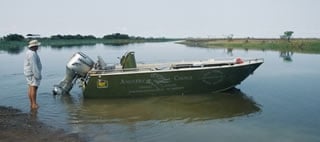
| Aussie guide Mick Mannix launches his custom-built Angler’s Choice in the Shady Camp billabong on the Mary River after scaring off the local crocs. |
The tip of my nine-foot spinning rod was bent under the stern as I desperately scrambled around Mick Mannix’s 24-footer to avoid the loss of whatever had swallowed my bait off the mouth of the Mary River in Australia’s Northern Territory. The most likely culprit was a black jewfish, a local heavyweight that resembles a giant weakfish and can weigh up to 100 pounds. Unfortunately, we’ll never know what I had hooked, because the fight ended a few minutes later when my line parted on the anchor line. But no worries, mate, because it turned out there would be plenty of action to go around on my recent trip to Australia’s rugged and remote “outbackwaters.”
When most anglers think of fishing in Australia, the first thing that comes to mind is pursuing giant black marlin on the Great Barrier Reef. To be sure, that’s a big attraction from September to December, though hardly one that absorbs the interest of most Aussie anglers, who have a huge variety of inshore game fish available to them, especially in the tropical northern end of the country.
The Northern Territory is Crocodile Dundee country, and presents a huge contrast to the Great Barrier Reef. The “Top End” is sparsely populated, except around the city of Darwin, and even the Australians who vacation there hardly put a dent in the local fisheries or create any crowding problems outside of Darwin Harbor. Waters not far from shore are clean, but not clear due to all the river systems flowing into the Arafura Sea.
SAMPLING NHULUNBUY
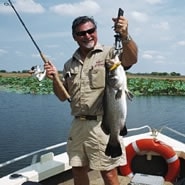
The author lip-grips a keeper barramundi, one of many species that live in the rich coastal waters of northern Australia.|
My trip last fall began with a two-hour Qantas flight from Cairns to Nhulunbuy, on the Gove Peninsula, where I fished two days with Nomad Charters in the waters off Bremer Island and Melville Bay. I also sampled some shore fishing while keeping an eye out for the region’s infamous crocodiles. There are only 3,500 people in Nhulunbuy, and most of them are involved with the big bauxite-mining operation there.
Nomad Charters uses a small aluminum party boat to fish these waters. Bottom fishing with small squid is the name of the game, and the targets are a variety of tropical species, including the highly desirable saddle-tail snapper and red emperor. As Captain John Walsh noted, there are lots of fine-eating fish in the area, yet the locals only want species with a reddish tint, such as the saddle-tail, for the plate.
Sharks were a big problem if the fish weren’t reeled in quickly, and a Swedish girl seemed to be getting dragged around the boat constantly before the inevitable break-offs. A stop on a wreck not far from the harbor in an attempt to catch black jewfish provided less variety and more sharks, although one angler did manage to catch a cobia and a jewfish in the 15-pound class.
I was told that yellowfin tuna have been known to enter the harbor at Nhulunbuy, but the best fishing takes place in the clear water farther from shore. Many private-boat anglers trailer to the Gove Peninsula in order to camp out for several days.
INTO THE WIND
One would assume that when you live in the Northern Territory, there would be little need to travel far from home to enjoy good fishing. However, when Mick Mannix picked me up at the beautiful Novotel Atrium Hotel in Darwin after my short flight from Nhulunbuy, I was surprised to learn that we still had a 191-kilometer drive ahead of us!
The first two-thirds of the trip went by fast, as our route took us over the Arnhem Highway, which has no speed limit outside of Darwin. However, Mannix had to keep his eye peeled for wallabies (small kangaroos) hopping across the road. Indeed, we eventually stopped to assist a driver who had hit a wallaby and was forced to remove a hanging bumper in order to continue. Being a veteran of wilderness driving, Mannix has every conceivable tool in his SUV and the problem was quickly solved.
The last third of the trip was over dirt roads, which were dry at the time, but can turn into a nightmare when the rains arrive. With the tide being wrong for launching in the morning of the first day, we fished on the billabong (fresh water lagoon) side of the “barrage,” a manmade barrier that that keeps salt water from encroaching during the dry season. Water is allowed to flow through the barrage when the monsoon rains start in January and February, and the best barramundi fishing occurs in March and April during the run-off.
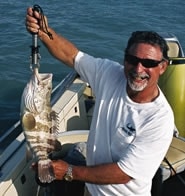
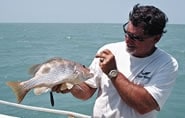
|
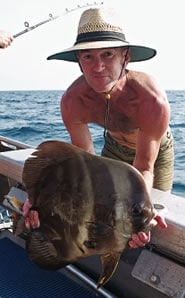
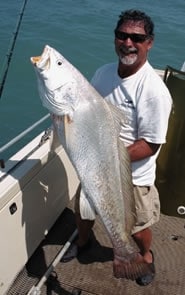
|The variety of fish taken by the author on his trip included grouper (top left), golden snapper (top right) and batfish (spadefish)(bottom left). (bottom right) Black jewfish, a member of the croaker family, live around the inshore reefs and grow to 100 pounds. This 42-pounder was caught off the mouth of the Mary River in 18 feet of water.|
Barramundi are the premier inshore game fish in Australia, and occupy the same basic ecological niche as our snook. They also fight and jump just like snook, but are comparable in size to striped bass, with a 50-pounder considered a trophy.
Barramundi have become a national obsession in Australia since their successful transplantation in huge reservoirs, where they commonly attain trophy sizes. Though devastated decades ago in many areas south of the Northern Territory by overfishing and ecological damage, regulations and environmental controls have since fueled a spectacular comeback. Even Jack Erskine, who popularized Great Barrier Reef black-marlin fishing from his famed tackle shop in Cairns, has become a barramundi fanatic, and now passes up the offshore scene in favor of traveling to seek trophy “barras,” especially on surface lures.
CROC WATCH
Mannix and I didn’t find any large barramundi in the billabong, as it was the end of the dry season, but we picked away at some that were just over the 55-centimeter (21.45 inches) minimum length. We took them on small plugs, but the real excitement was provided by the local crocodiles. The Mary River has one of the largest populations of salt water crocodiles in the world, and while they aren’t usually aggressive, it’s important to be alert at all times.
I found that out after lunch while our boat was tied to an overhanging tree on the billabong. When I started to dip my tray in the water to wash it off, Mannix shouted a warning. Sure enough, seconds later a croc stuck his head out in that very spot to see where his Yankee dinner had gone. Mannix was well aware of the danger because his wife, Emma, had done the same thing the previous year and still sports a mark where a croc grabbed her arm before Mannix managed to scare it off.
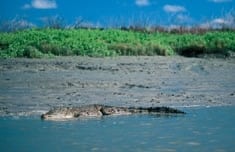
(right) Crocodiles are numerous in the coastal rivers of the Northern Territory, and demand the respect of anglers.|
Another thing I discovered was that the huge tides here must be taken into account when planning the fishing day. We stayed overnight at Mary River Park, about an hour away, and launched in the dark for another hour of high-speed running before pulling into an offshoot of the river and walking through the stickiest mud I’ve ever encountered. Mannix abandoned his shoes right away, and the ones I was wearing became so heavy with clinging mud within a few steps that it was necessary to slip out of them. Though there are usually some barramundi near the mud banks we walked to, a few casts with small poppers didn’t produce anything, so we slogged back to the boat and spent five minutes hosing the thick goo from our feet.
There was still more running to do before we reached the mouth of the Mary River and moved out a few miles to anchor on some unseen coral patches in 18 feet of water. The surface was brownish from the river flow, but the reefs showed up clearly on Mannix’s depthsounder.
Although my host assured me we were seeking large fish, the baits were modest. Strips of squid and pieces of pilchard were quickly attacked by smaller fish, and my first catch was a six-pound rock cod, a type of grouper. The smaller fish threatened to wipe us out, and we ended up using strip baits before the black jewfish found us.
The first one I hooked felt like a real horse as it pulled me all around the boat, but the majority of the dozen we caught ran 15 to 20 pounds, with several pushing 30 pounds and one 42-pounder. Despite their name, black jewfish are members of the Sciaenidae family, which includes our much smaller weakfish and spotted seatrout, plus a few giants like the white seabass, red drum and black drum. Like many of their family members, black jewfish make a croaking sound, which, in the case of the larger specimens (they can grow to 100 pounds), can be quite loud.
No one I spoke with seemed to know where black jewfish got their name, as they resemble a plain-looking, silvery weakfish and aren’t shaped anything like the jewfish of the Atlantic, which was recently renamed goliath grouper. Mannix did note that the few he kept for food developed a black tint in the fishbox, so perhaps that has something to do with it.
Mannix and I eventually ran inshore to try a patch reef in just ten feet of water, where we continued to pick away at jewfish. Mixed in were more rock cod, golden snapper up to 3 1/2 pounds, and a couple of blue salmon, an odd-looking fish that Mannix said made the best strip baits for jewfish.
LOCAL CHALLENGES
Because of the huge tide difference in this region, hauling the boat after a great day of fishing isn’t the simple matter we’re used to in the States. Mannix and I had to wait, along with three other small boats, for the rising tide to provide enough water to even get to the ramp – but that wasn’t our only problem.
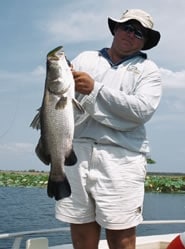
Barramundi are the premiere inshore game fish in Australia, for good reason. They fight hard, can weigh over 50 pounds, and will readily attack plugs, jigs and flies. |
Up to this point, my entire trip had taken place in ideal weather, with warm days, modest winds and lots of sunshine. However, early November is a period when occasional brief thunderstorms blast the Northern Territory well in advance of the monsoons, and such a storm was approaching as we made ready to leave Shady Camp with Mannix’s boat in tow. The dirt road soon turned slippery, and trees were being toppled by the gale-force winds. One tree had fallen across the road, and defied our best efforts to move it as thunder and lightning crashed around us and we were soaked by the driving rain. Mannix tried to reach a park ranger on his satellite phone, but it soon became obvious we’d have to do the job ourselves or wait until someone showed up the next day.
Mannix judged there was just barely enough room to drive over the smaller branches on the side of the road, and I guided him to keep the SUV and trailer from slipping into a ditch. As I said to Mannix, “If I had to trailer a boat 191 kilometers under these conditions and then run over an hour in order to put a party into prime fishing, I’d soon give up the charter business.”
For his part, Mannix seems perfectly content to put in all that effort, but has a better deal set up for the prime run-off period. In March and April he plans to operate from a mothership in the mouth of the Mary River, so that his anglers can fish several days in comfort while making only one trip to and from the site.
Australia is a fascinating country that deserves a lot more time than I was able to give it. Though I only scratched the surface of all the possibilities, the off-season fishing was certainly impressive, and I’m looking forward to returning. I can’t wait to sample more fishing with some of the world’s most dedicated anglers and watch them develop techniques in what are still relatively virgin areas.
| ### AUSTRALIAN ODYSSEY¿ |









